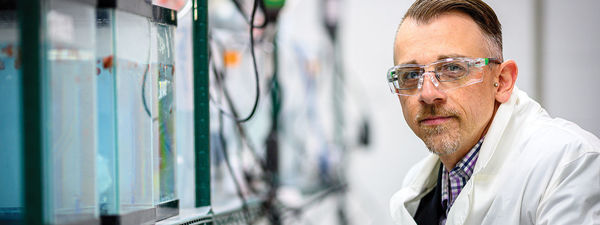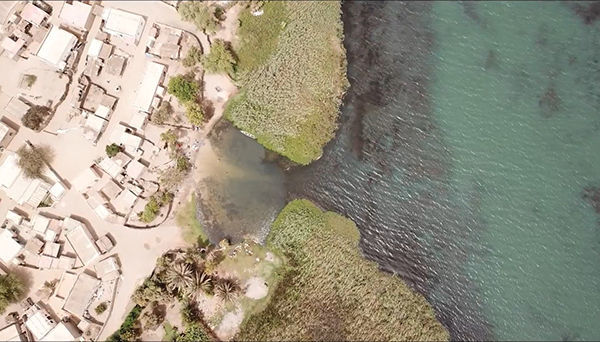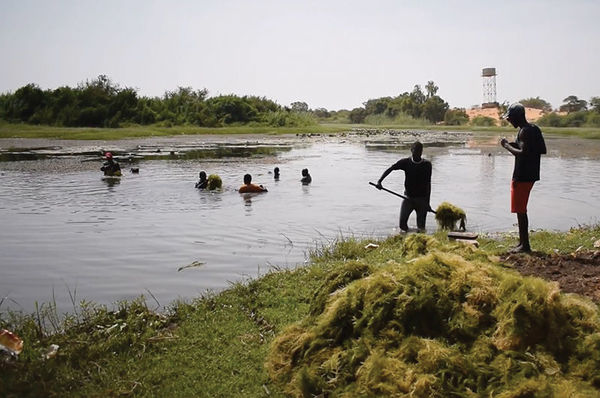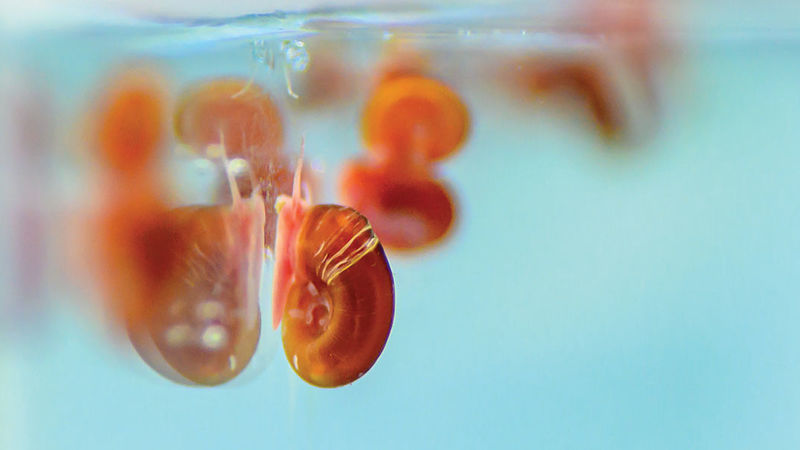In parts of Senegal where Notre Dame ecologist Jason Rohr works every summer to eradicate an insidious parasitic disease called schistosomiasis, the way children answer a basic biology question hints at the infection’s pervasiveness. The kids don’t realize what color their pee should be.

“Children in many of these villages think that the natural color of their urine is pink,” says Rohr, the Galla College Professor of Biological Sciences. “In fact, in many areas, you can somewhat reliably assess prevalence of schisto just by asking children what the color of their urine is.”
Traces of blood in the urine is just one indication of schistosomiasis, which Rohr describes as the second-most debilitating global disease — after malaria. The ailment presents bladder, liver, spleen and gastrointestinal threats. Fluid buildup around the abdomen can lead to organ failure. And while the disease harms people of all ages, the energy the body expends in its immune response especially hinders physical and mental development in children.
Many experience distended stomachs. The children with swollen bellies in those 1980s television pleas to feed the hungry in Africa, Rohr says, might well have been suffering not from malnutrition — itself an intractable problem across the continent — but from schistosomiasis.
All but unheard of in the United States, schistosomiasis is a familiar part of the vernacular for people in the 16 Senegalese villages where Rohr conducts his research, as well as many other places in sub-Saharan Africa, Southeast Asia and the Caribbean. Some areas see infection rates of 70 to 90 percent, with many people suffering on multiple occasions in their lifetimes.
Schisto, for short, doesn’t kill as many people as malaria or other, better-known diseases such as tuberculosis and HIV, but it claims more than 200,000 lives a year. An estimated 200 million people have it right now, with three to four times that many at risk — about one in 10 people on the planet. As populations expand in tropical, developing countries over the coming decades, the exposure rate will only increase.
More people will mean more problems in preventing schisto. The ecological conditions that propel its spread are entwined, like a swimmer’s leg snagged in an underwater plant, with everyday needs like food production and the availability of water for cooking and cleaning.
In a 2019 article in Nature Sustainability, Rohr highlighted the threats population growth presents to public health and the environment. By the year 2100, demographers project an estimated 11 billion people on Earth, with many of the additional 3 to 4 billion individuals living in regions where infectious diseases now account for around 75 percent of deaths. To feed so many people will require devoting additional land to agriculture, which will introduce more chemicals from farm fields into waterways, both an ecological concern and a recipe for even higher schisto risk.
Unless . . .
Rohr is trying to untangle the complex factors at play. His research interest extends far beyond reducing exposure to schistosomiasis. Complementary goals include the development of more efficient and productive farms, cheaper and greener fuel and increased access to clean water.
His lab sums up its mission with an acronym: DFEWS, which spells out the ambitious intention to identify disease, food, energy and water solutions. They mean to “defuse” a global crisis.
More than defuse, in fact. By instituting sustainable practices that can be managed locally, Rohr hopes to create conditions for productive living outside the long shadow that illness casts across entire societies. “We’re hoping, by addressing multiple issues that these people will deal with,” he says, “that we’re likely to improve quality of life.”
First step: Root out the cause of the disease. Parasitic flatworms, transported by the thousands on snails that feed on vegetation in tropical lakes and rivers, penetrate a person’s skin and enter the bloodstream.


Different forms of the disease manifest in different ways, with the worms migrating to veins around the bladder or nesting in the gastrointestinal tract, where they lay eggs. Humans expel some eggs through urination and defecation, but these flow into the local water sources, hatch, infect snails and start the process all over again.
The immune system marshals a response to the eggs that remain in a person’s body, isolating the invaders with white blood cells, a process that causes its own complications. “You get fibrotic and scar tissue that builds up around every one of these eggs,” Rohr says. And as they build up over time, “you get more and more scar tissue, and then you get organ failure.”
The eggs build up because of repeated exposure to schisto. Since the vicious cycle supports a steady population of infected snails in water that people use every day, the disease persists. The impact of chronic infections accumulates over a lifetime.
Drugs work, but they can be inaccessible in many remote communities (and another facet of Rohr’s work involves the study of ways to expand drug distribution). Adults develop some resistance to multiple exposures, but the impact dating to childhood is irreversible, with prolonged effects that define schisto as a “poverty-reinforcing” illness. Education and long-term economic potential suffer in places where the disease is endemic “because the kids are tired, lethargic, stunted in their growth, stunted in their cognitive development,” Rohr says. “And therefore, when they get to adulthood, they don’t have the same capacities as children who don’t have the disease.”
Rohr, who studied at Binghamton University and came to Notre Dame last year from the University of South Florida, has shown that schisto is especially prevalent in heavy agricultural regions. When excess fertilizer washes into waterways, aquatic vegetation proliferates, attracting the snails with worms in tow. “A lot of the nitrogen and phosphorus in that fertilizer is sucked up by submerged plants or sucked up by algae,” he says. “Which is a food source for the snails.”
His awareness of this disease cycle began with the study of sick frogs, whose declining populations serve as a harbinger of global ecological threats. Research into another type of snail-borne parasitic flatworm infection in amphibians indicated patterns of illness related to agricultural runoff in the frog habitats. His lab also established that certain insecticides used on farms kill off insect predators that would eat the snails, an additional boost to the parasite-carrying population.
Did the same model that threatened the frogs hold, the researchers wondered, for the way schistosomiasis spreads to humans? “We basically discovered that yes, indeed, we get these same sorts of dynamics,” says Rohr, whose work has evolved a long way from his days as a doctoral student exploring “mate search and predator avoidance in the eastern red-spotted newt.”
When people back then asked what he studied, their next question would be, “Why?” He didn’t have an answer that satisfied even himself. Thinking back now, he wishes someone had encouraged him to “think bigger sooner,” to look beyond what he calls “esoteric” research toward something with more obvious relevance, a clear “why.” He has that now; the “how” is the challenging part.
Along with locals in the Senegalese villages where he spends summers, Rohr and his staff, in waders up to their chests and shoulder-length gloves, go into the water and pull out vegetation by the metric ton. (They’re all tested for schisto every six months. Nobody has been infected.)
Eliminate their nourishment, the logic goes, and eliminate the snails. The process, Rohr says, is like clearing crabgrass from an overgrown lawn. First time through, it can be an endless nightmare — on the high end, the DFEWS team collects 50 to 80 metric tons of vegetation from some Senegalese waterways — but after that, it’s a matter of upkeep. Depending on the size of the water-access point, follow-up harvests typically yield from one to five metric tons of plants.
Regrowth is inevitable in waterways near agricultural areas, but that’s OK. The plant material actually is vital for the lab’s efforts to go beyond the reduction of schistosomiasis and achieve the food, water and energy elements of its broader, ecological mission.
In the scenario Rohr envisions, the vegetation that now nurtures the spread of disease becomes a beneficial resource. The plants hauled out of the water carry nourishment that can be repurposed on farms to save money and increase yields. “We’re in a process of turning this aquatic plant material into compost and applying it back onto the problem fields, to basically recycle those nutrients,” Rohr says. “And we have shown that we get very significant increases in pepper and onion production, which are the major crops in Senegal, when we add this compost onto their fields.”
Here’s where Rohr’s vision takes on the “But wait, there’s more!” tenor of an infomercial.
Those piles of aquatic vegetation also attract hungry livestock. Rohr speculates that, in the dry region where he works, just south of the Sahara, the substantial water content of the plants, plus their nourishing minerals, makes them appealing to cattle and other farm animals. So his lab is testing the viability of adapting some of what they pull from the water into a livestock feed.
This summer, they’ll try to go a step further, using biodigesters to achieve what the composting does now — but cleaner and with additional benefits. With composting, Rohr says, “the heat and the gas is typically released into the environment. Biodigesters will capture those gases that are released. And those . . . can be used as cooking gas, or they can be used to fuel generators to produce electricity.”
In those ways, a single, problematic resource — aquatic vegetation that now feeds the carriers of a debilitating disease — could be removed to eliminate the health threat and applied to remedy an array of associated nutritional and environmental issues.
Accomplishing all this requires not only scientific validation of the procedures, which his lab has been gathering for years — such as data showing significant reductions in schisto reinfection rates near water where vegetation has been removed. Local villagers also must be adept at doing the work themselves in order to maintain the benefits after the researchers have gone.
“We need to train them first, remove the foreigner assistance from the equation and evaluate compliance,” Rohr says. “How well is the intervention maintained, and how long is it maintained? And also evaluate spread. How well do they spread this knowledge of effectiveness to other villagers and villages?”
Knowing where and when to harvest the regrown vegetation, for example, benefits from precise monitoring with satellite technology. Satellite data has the potential to give faraway researchers almost real-time information on the location and accumulation of regrowth to help determine whether there’s enough to justify the extraction effort.
“We can just alert the village chieftains, theoretically, when it’s worthwhile to go ahead and pull the vegetation again. Because you don’t want to do it weekly,” he says, citing exposure risks and cost-effectiveness.
In time, the data could be the basis of a map that identifies locations with the greatest prevalence of regrowth and, therefore, the highest schisto risk. Then researchers could focus their training around villages where it would have the greatest impact in preventing disease.
“Target those locations, do the training and then also potentially couple that with some more real-time monitoring and a cellphone alert system,” Rohr says. “That way we can keep people safe.”
And not only safe from disease, but from other encroaching nutritional and environmental pressures caused by a growing population. The DFEWS roadmap also leads to the allocation of resources that would reduce additional land needed for agriculture and expand the availability of clean water and energy.
Rohr’s research has such potential to benefit human and ecological health that the MacArthur Foundation in February designated DFEWS as one of the top 100 submissions in a competition called 100&Change to award $100 million to a single proposal. There are more hurdles to clear before the winner is named next fall, but the February milestone put the project in the top 21 percent of entries with the potential to make “real and measurable progress in solving a critical problem of our time.”
The scope of what Rohr has set out to accomplish — the critical problems, plural, that he’s intent on solving — is a testament to the scientific ambition he has cultivated in two decades as an ecologist. Now when people ask about his research, and he explains its implications for human and environmental health, nobody wonders why.
Jason Kelly is an associate editor of this magazine.
